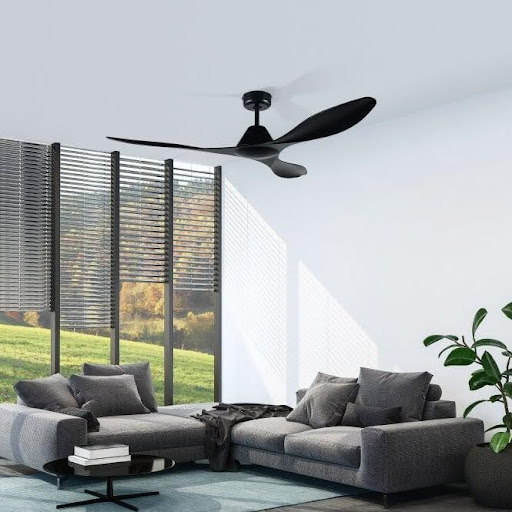Ceiling fans that are installed by a reliable Ceiling Fan Installation Colorado Springs are the most essential fixtures of our homes that provide us with lots of comfort and circulation. However, like any electrical appliance, they can encounter issues that can impact their overall functionality.
In this blog post, we will understand common ceiling fan problems and provide easy-to-understand solutions to help you with that. So let’s not wait any longer and jump right into it!
1. Fan Not Turning On:
If your ceiling fan isn’t turning on, the first step is to check the power source. Ensure the fan is securely plugged in and that there are no issues with the electrical outlet. If the fan is connected to a wall switch, make sure the switch is in the “on” position. Additionally, inspect the circuit breaker to ensure it hasn’t tripped. If these basic checks don’t resolve the issue, move on to the fan’s control mechanism. Examine the pull chain for any damage and, if your fan has a remote control, check the batteries. Faulty pull chains or depleted batteries can hinder the fan’s ability to turn on, and addressing these issues is often a quick and simple fix.
2. Inconsistent or Slow Speeds:
Inconsistent or slow fan speeds may be indicative of a malfunctioning capacitor. The capacitor plays a crucial role in regulating the speed of the ceiling fan. If you notice irregularities in the fan’s speed, consider replacing the capacitor. Begin by turning off the power to the fan. Remove the fan housing to access the capacitor. Note the capacitor’s specifications and purchase a replacement of the same rating. Install the new capacitor, following the manufacturer’s guidelines. This straightforward replacement can often restore the fan’s speed to its optimal performance.
3. Wobbling Issues:
Wobbling fans can be both a nuisance and a potential safety concern. Start by checking the tightness of the screws or bolts holding the blades to the brackets. Loose connections can contribute to wobbling. If the blades are securely attached, but wobbling persists, consider using a blade balancing kit. These kits typically include weights that can be attached to the blades to balance their distribution. Follow the kit instructions to identify and correct any imbalance, restoring your fan’s stability.
4. Strange or Noises:
Unusual noises emanating from your ceiling fan can be a sign of underlying issues. Begin by inspecting the blades for any obstructions or loose components. Tighten screws and ensure the blades are correctly aligned. If the noise persists, the issue might be with the motor. Many ceiling fan motors benefit from periodic lubrication. Use a fan-approved oil to lubricate the motor, following the manufacturer’s recommendations. This simple maintenance step can often eliminate strange noises and ensure smooth operation.
5. Fan Blades Not Turning:
If your ceiling fan’s motor is running, but the blades aren’t turning, the issue may be a loose blade or a worn-out flywheel. Begin by checking for a loose blade and tightening any screws or bolts. If the blades are secure, inspect the flywheel for damage. A damaged flywheel can hinder the transfer of motion from the motor to the blades. If the flywheel is the culprit, consider replacing it to restore proper functionality.
6. Dim Light Operation:
Ceiling fans with integrated lights may experience dimming issues, often related to the type or wattage of bulbs used. Ensure you are using the correct wattage and type of bulb recommended by the manufacturer. If the issue persists, inspect the wiring and connections within the light kit. Loose or faulty wiring can impact light performance. If necessary, seek professional assistance to examine the light kit and wiring for any potential issues that may require repair or replacement.
7. Fan Remote Control Problems:
Ceiling fans equipped with remote controls may encounter operational issues, and these can often be resolved with simple troubleshooting steps. Begin by replacing the batteries in the remote control and ensuring they are correctly inserted. If the remote control still doesn’t work, check for any obstructions between the remote and the fan receiver. If the problem persists, refer to the fan’s manual for reprogramming instructions. It’s also worthwhile to ensure that the remote and receiver are on the same frequency, as mismatched frequencies can lead to operational issues.
8. Excessive Wobbling During Operation:
While slight wobbling is normal, excessive movement can be problematic and compromise both comfort and safety. Check for any bent blades, as even a slight misalignment can contribute to excessive wobbling. A blade balancing kit can be an effective solution, providing weights that can be attached to the blades to correct any imbalances. Additionally, ensure that the downrod is securely attached to the mounting bracket, and the mounting bracket is firmly secured to the ceiling. These structural elements play a crucial role in maintaining the fan’s stability.
Conclusion
The above-mentioned are some of the most common ceiling fan problems and how you can solve these if you want to enjoy smooth functioning of your ceiling fans. Make sure to use this guide whenever you face any of the issues mentioned above.





